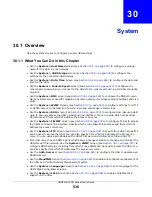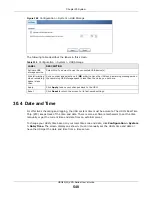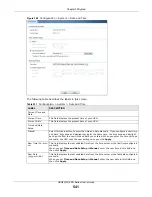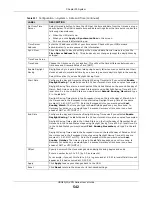
Chapter 29 Object
USG20(W)-VPN Series User’s Guide
527
The following table describes the labels in this screen.
Table 223
Configuration > Object > Certificate > Trusted Certificates > Edit
LABEL
DESCRIPTION
Name
This field displays the identifying name of this certificate. You can change the name.
You can use up to 31 alphanumeric and ;‘~!@#$%^&()_+[]{}’,.=-
characters.
Certification Path
Click the
Refresh
button to have this read-only text box display the end entity’s
certificate and a list of certification authority certificates that shows the hierarchy of
certification authorities that validate the end entity’s certificate. If the issuing
certification authority is one that you have imported as a trusted certificate, it may be
the only certification authority in the list (along with the end entity’s own certificate).
The USG does not trust the end entity’s certificate and displays “Not trusted” in this
field if any certificate on the path has expired or been revoked.
Refresh
Click
Refresh
to display the certification path.
Enable X.509v3 CRL
Distribution Points
and OCSP checking
Select this check box to turn on/off certificate revocation. When it is turned on, the
USG validates a certificate by getting Certificate Revocation List (CRL) through HTTP or
LDAP (can be configured after selecting the
LDAP Server
check box) and online
responder (can be configured after selecting the
OCSP Server
check box).
OCSP Server
Select this check box if the directory server uses OCSP (Online Certificate Status
Protocol).
URL
Type the protocol, IP address and path name of the OCSP server.
ID
The USG may need to authenticate itself in order to assess the OCSP server. Type the
login name (up to 31 ASCII characters) from the entity maintaining the server (usually
a certification authority).
Password
Type the password (up to 31 ASCII characters) from the entity maintaining the OCSP
server (usually a certification authority).
LDAP Server
Select this check box if the directory server uses LDAP (Lightweight Directory Access
Protocol). LDAP is a protocol over TCP that specifies how clients access directories of
certificates and lists of revoked certificates.
Address
Type the IP address (in dotted decimal notation) of the directory server.
Port
Use this field to specify the LDAP server port number. You must use the same server
port number that the directory server uses. 389 is the default server port number for
LDAP.
ID
The USG may need to authenticate itself in order to assess the CRL directory server.
Type the login name (up to 31 ASCII characters) from the entity maintaining the server
(usually a certification authority).
Password
Type the password (up to 31 ASCII characters) from the entity maintaining the CRL
directory server (usually a certification authority).
Certificate
Information
These read-only fields display detailed information about the certificate.
Type
This field displays general information about the certificate. CA-signed means that a
Certification Authority signed the certificate. Self-signed means that the certificate’s
owner signed the certificate (not a certification authority). X.509 means that this
certificate was created and signed according to the ITU-T X.509 recommendation that
defines the formats for public-key certificates.
Version
This field displays the X.509 version number.
Serial Number
This field displays the certificate’s identification number given by the certification
authority.
Subject
This field displays information that identifies the owner of the certificate, such as
Common Name (CN), Organizational Unit (OU), Organization (O) and Country (C).
Summary of Contents for ZyWall USG20-VPN
Page 17: ...17 PART I User s Guide ...
Page 18: ...18 ...
Page 99: ...99 PART II Technical Reference ...
Page 100: ...100 ...



































